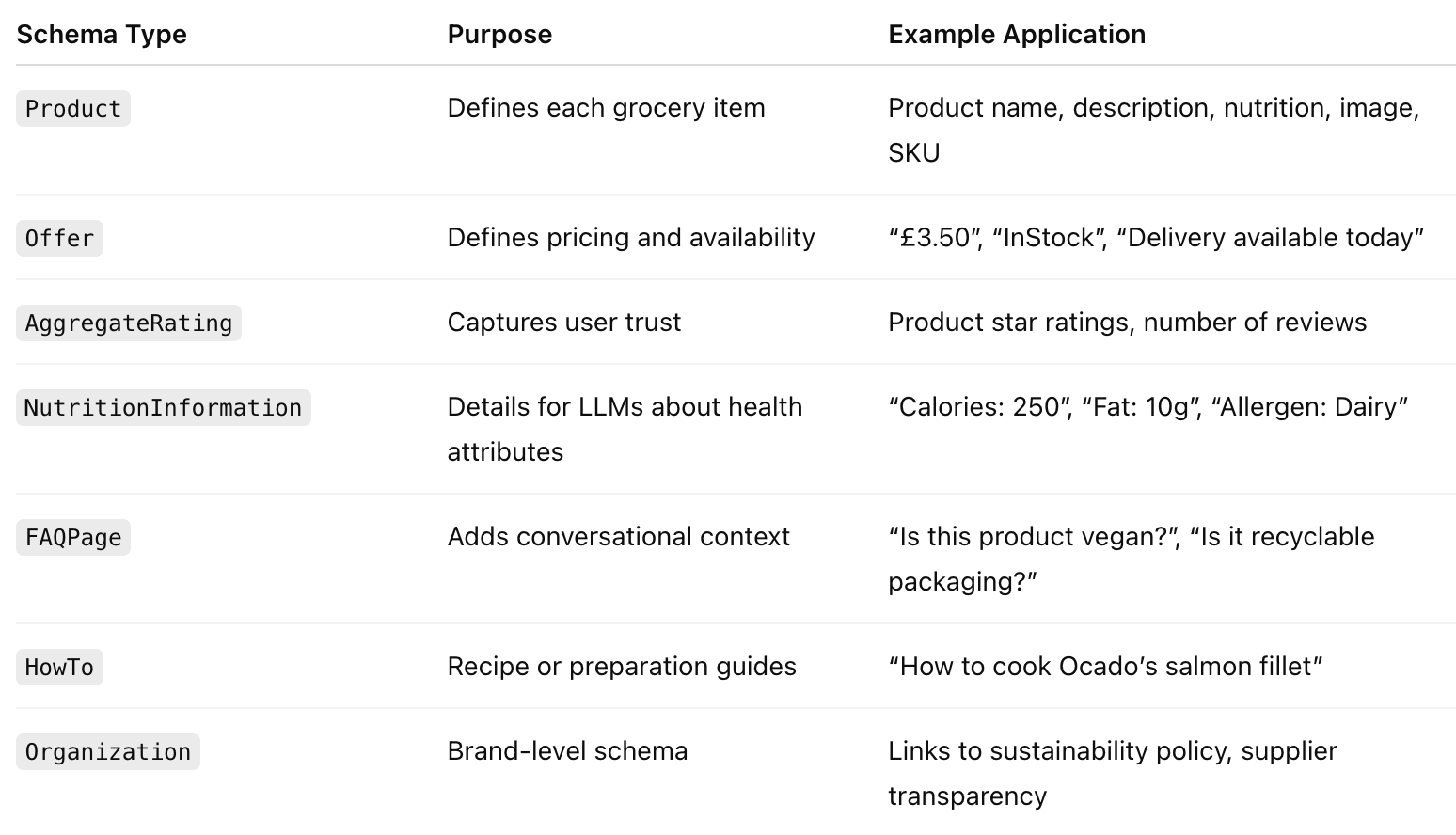Ocado SEO + AI Visibility Solution
1. The Core Problem
SEO Challenges:
Dynamic product inventory leads to frequent broken links or discontinued URLs.
Duplicate content between product variants (sizes, packaging, flavours).
Thin content on category pages (relying mostly on images and product names).
Large-scale crawl budget inefficiency — Google can’t effectively index millions of SKUs.
Lack of FAQ and informational content on product and category pages, limiting long-tail discovery.
AI Visibility Challenges:
LLMs like ChatGPT, Gemini, and Perplexity don’t “see” Ocado data directly — they rely on structured sources like Wikipedia, Reddit, and recipe datasets.
Ocado’s schema is incomplete — AI models can’t infer freshness, ingredients, ethical sourcing, or delivery speed.
Queries like “best grocery delivery for organic produce” often cite Tesco or Sainsbury’s, not Ocado.
2. Strategic Goal
Transform Ocado’s website from a product catalogue into an AI-readable grocery intelligence hub
— so that both Google and LLMs can understand, rank, and cite Ocado’s inventory, values, and differentiators.
3. Technical SEO Foundations
a. Crawl Budget Optimization
Audit site structure to ensure Googlebot prioritizes key pages:
Category → Subcategory → Product → Review.
Block faceted navigation and unnecessary query strings (e.g.,
/filter=price&brand=...) viarobots.txtand canonicalization.Generate priority sitemaps for top-performing categories (fresh food, household, baby products).
b. Structured Pagination & Internal Linking
Use rel="next" and rel="prev" on paginated category pages.
Add contextual “related product” modules to enhance crawl depth and time on site.
c. Server-Side Rendering (SSR)
Ensure JavaScript-rendered product listings are pre-rendered for search engine crawlers.
Preload critical category pages and high-converting SKUs for faster indexing.
d. Canonical Tag Strategy
Prevent duplication between size or pack variants:
Canonicalize
/product/organic-bananasinstead of/product/organic-bananas-5-pack.
4. Structured Data (Schema.org) — Core to AI Visibility
Structured data transforms Ocado’s site from “a shop” into “a knowledge base” that AI models can cite.
Key Schema Types to Implement:
Example JSON-LD Snippet:
{
"@context": "https://schema.org/",
"@type": "Product",
"name": "Ocado Organic Bananas",
"description": "Fresh organic bananas, fair trade certified, packed in compostable bags.",
"brand": { "@type": "Brand", "name": "Ocado" },
"image": "https://ocado.com/images/products/bananas-organic.jpg",
"sku": "OCA12345",
"offers": {
"@type": "Offer",
"price": "1.99",
"priceCurrency": "GBP",
"availability": "https://schema.org/InStock",
"url": "https://ocado.com/product/ocado-organic-bananas/12345"
},
"nutrition": {
"@type": "NutritionInformation",
"calories": "90 kcal per 100g"
},
"aggregateRating": {
"@type": "AggregateRating",
"ratingValue": "4.7",
"reviewCount": "512"
}
}
5. Content Strategy — SEO + AI Synergy
a. Category-Level Content Refresh
Add 200–300 words of editorial content per category, answering user intent:
“What makes organic produce worth it?”
“Best eco-friendly cleaning products for families.”
“Low-calorie snacks under 100 kcal.”
Include FAQs in markup format (
FAQPageschema).
b. AI-Friendly Topic Hubs (“Grocery Wikis”)
Create structured, evergreen content hubs on:
Sustainability & sourcing: “Where does Ocado’s produce come from?”
Nutrition & dietary filters: “Best high-protein vegetarian meals.”
Shopping tips: “How to plan a weekly Ocado delivery under £50.”
These hubs serve both SEO intent and AI training data needs.
c. Recipe Integration
Embed HowTo schema for recipes featuring Ocado ingredients.
Link recipes directly to products (
ProductandOfferschema cross-linking).Add “Buy Ingredients” buttons to boost conversion.
6. AI Visibility Enhancements
a. Prompt-to-Product Mapping
Develop an internal “AI Visibility Engine” that maps common AI prompts to product categories and schemas.
Example:
AI PromptTarget SchemaExample Answer Source“Best gluten-free pasta”Product + FAQOcado’s Barilla Gluten-Free Pasta page“Healthy snacks for kids”CategoryOcado Kids’ Snack Hub“Best online grocery for same-day delivery”OrganizationOcado’s delivery information schema
b. LLM Citation Optimization
Introduce a llm.txt file to guide AI crawlers:
User-agent: ChatGPT Allow: /products/ Allow: /recipes/ Disallow: /cart/ Sitemap: https://ocado.com/sitemap_ai.xmlProvide AI sitemap feeds with structured summaries and product data for models to ingest.
c. Wikipedia & Wikidata Integration
Update the Ocado Wikipedia page with structured citations for delivery times, sustainability initiatives, and unique product lines (with citations from Ocado’s own pages).
Add a Wikidata entity for “Ocado Organic Range,” referencing official URLs and identifiers.
d. AI Overview Readiness
Ensure category pages have question-led, schema-marked content:
“What are Ocado Smart Pass benefits?”
“Is Ocado more sustainable than Tesco?”
These FAQs feed directly into Google’s AI Overviews summaries.
7. Measurement & Monitoring Framework
8. Implementation Roadmap
9. Expected Outcomes
Improved SERP dominance: Category and product pages rank higher due to enhanced crawlability and unique, structured content.
Inclusion in AI Overviews: Ocado content cited in AI-generated summaries for “best online grocery” and “organic grocery delivery UK.”
Enhanced trust and brand authority: Clear structured data allows models and users to verify Ocado’s freshness, ethical sourcing, and pricing.
Higher CTR from snippets: Rich results, FAQs, and ratings drive user engagement.
AI visibility moat: Ocado becomes the default grocery reference source across models.
10. Future Expansion
AI Shopping Integrations — enable ChatGPT or Google Gemini to shop Ocado baskets directly.
Voice & Multimodal Search — optimize for queries like “add milk and cereal to my Ocado basket.”
Partnership with recipe AIs — ensure Ocado ingredients are the default in AI-generated meal plans.
Personalized LLM API Feed — structured API for AI agents (diet-based or region-specific shopping assistants).
Summary
SEO makes Ocado discoverable.
AI Visibility makes Ocado interpretable and recommendable.
By combining technical SEO, structured schema, prompt mapping, and AI audit integration, Ocado can dominate both search results and AI-driven recommendations — ensuring that whether users search, ask, or speak, the answer starts with Ocado.




